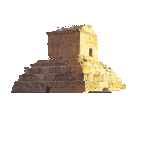|
Achaemenid Art
|
Stone relief from
Persepolis showing a servant
Achaemenid, 4th century BC
From Persepolis, south-west Iran
A servant in the royal court of Persia
This relief from Persepolis shows a servant wearing so-called Median
dress: a distinctive knee-length tunic,
tightly fitting trousers and a cap with ear-flaps and neck-guard. This is
different from the usual Persian costume of a long pleated dress. He also
wears the akinakes,
or typical Achaemenid short sword. In 550BC Cyrus the Great, of the ruling
house of Persia, deposed the Median king Astyges, who, according to
tradition, was his grandfather. Amongst his ancestors he counted the
legendary king Achaemenes, hence 'Achaemenid' as the dynastic name.
Towards the end of the reign of Cyrus' son, Cambyses (530-522 BC), a
revolt broke out. On his way to deal with the problem, Cambyses was
accidentally killed. The rebellion was eventually crushed by a group of
seven conspirators and one of them, Darius, became the next king. He was
keen to stress his legitimacy and founded Persepolis as a new royal
centre. His successors Xerxes, Artaxerxes I and Artaxerxes III continued
to build at Persepolis. This relief probably dates to the reign of
Artaxerxes III (359-338 BC) and comes either from the so-called 'Palace of
Darius' or from another building known to archaeologists as 'Palace G'. It
was therefore among the last sculptures created at Persepolis, as the site
was destroyed by Alexander the Great in 330 BC.
Height: 75.5 cm
Back to
the top |
Back |




